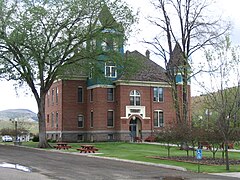Wheeler County, Oregon
| Wheeler County, Oregon | |
|---|---|

Wheeler County Courthouse in Fossil
|
|
 Location in the U.S. state of Oregon |
|
 Oregon's location in the U.S. |
|
| Founded | February 17, 1899 |
| Seat | Fossil |
| Largest city | Fossil |
| Area | |
| • Total | 1,715 sq mi (4,442 km2) |
| • Land | 1,715 sq mi (4,442 km2) |
| • Water | 0.5 sq mi (1 km2), 0.03% |
| Population (est.) | |
| • (2015) | 1,358 |
| • Density | 0.8/sq mi (0/km²) |
| Congressional district | 2nd |
| Time zone | Pacific: UTC-8/-7 |
| Website | www |
Wheeler County is a county in the U.S. state of Oregon. As of the 2010 census, the population was 1,441, making it Oregon's least populous county. The county seat is Fossil. It is named in honor of Henry H. Wheeler, an early settler who owned a farm near Mitchell.
Wheeler County is known for having the state's largest deposit of fossils.
Wheeler County was created on February 17, 1899, from parts of Grant, Gilliam, and Crook Counties. There have been no boundary changes since its creation. Fossil was designated the temporary county seat at the time of the county's creation. In 1900 there was an election to determine the permanent county seat between the three towns of the county, which ended with Fossil winning the election.
According to the U.S. Census Bureau, the county has a total area of 1,715 square miles (4,440 km2), of which 1,715 square miles (4,440 km2) is land and 0.5 square miles (1.3 km2) (0.03%) is water.
As of the census of 2000, there were 1,547 people, 653 households, and 444 families residing in the county. The population density was 1 people per square mile (0/km²). There were 842 housing units at an average density of 0 per square mile (0/km²). The racial makeup of the county was 93.34% White, 0.06% Black or African American, 0.84% Native American, 0.26% Asian, 0.06% Pacific Islander, 3.49% from other races, and 1.94% from two or more races. 5.11% of the population were Hispanic or Latino of any race. 20.6% were of German, 18.0% English, 13.6% American, 8.2% Irish and 6.9% Scottish ancestry.
...
Wikipedia
